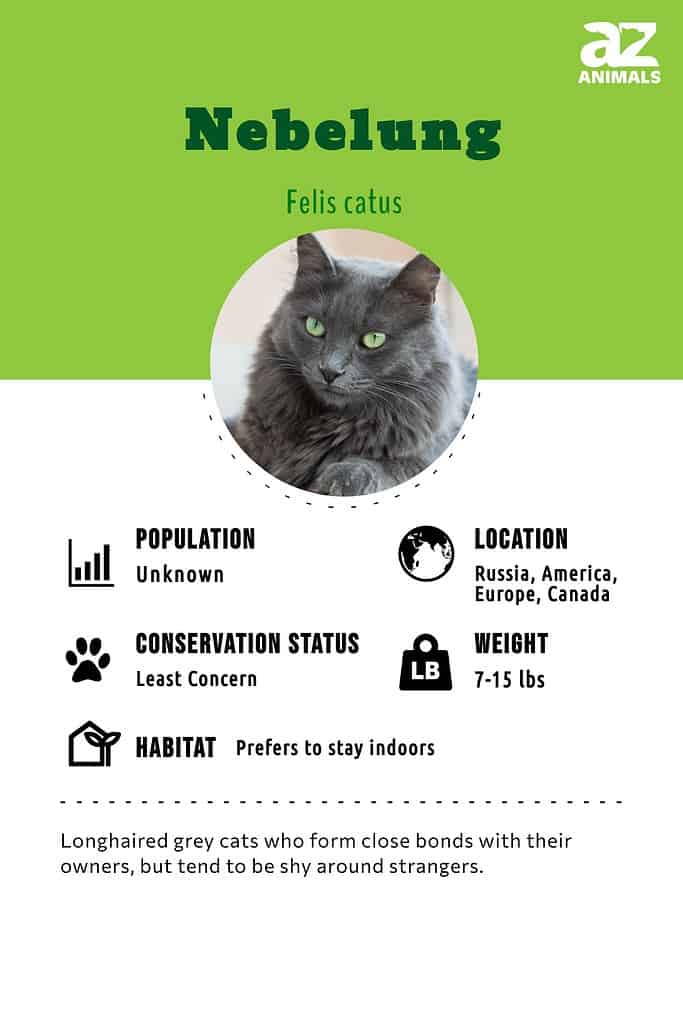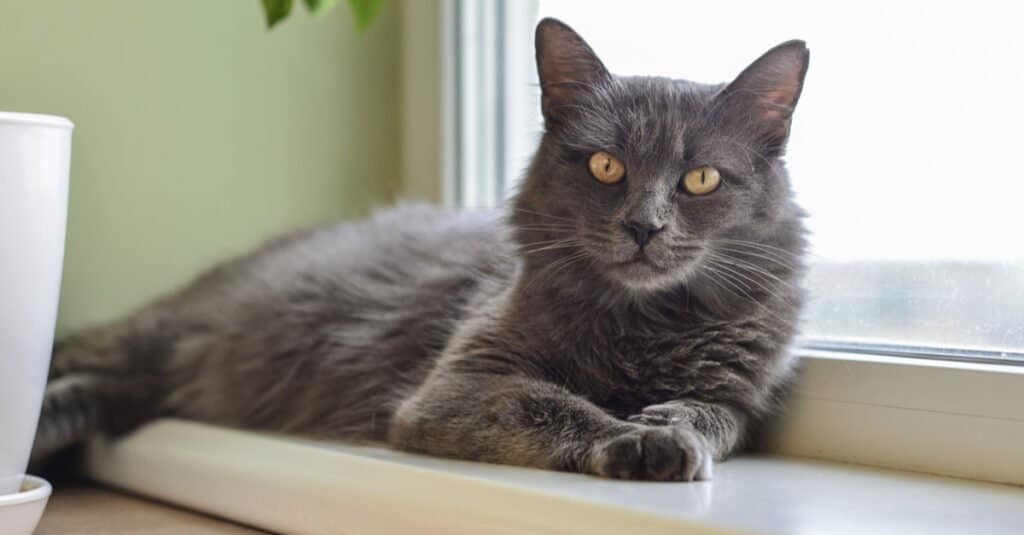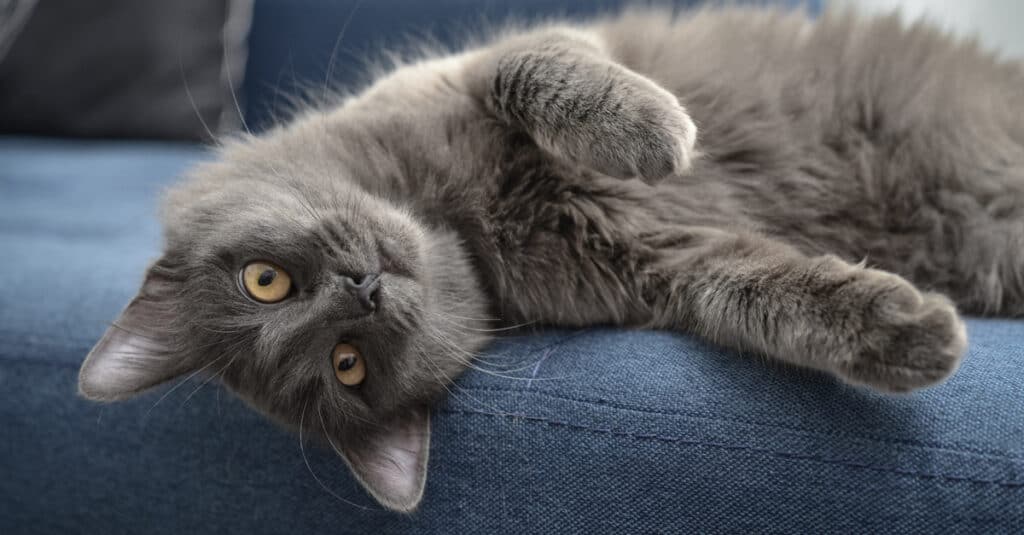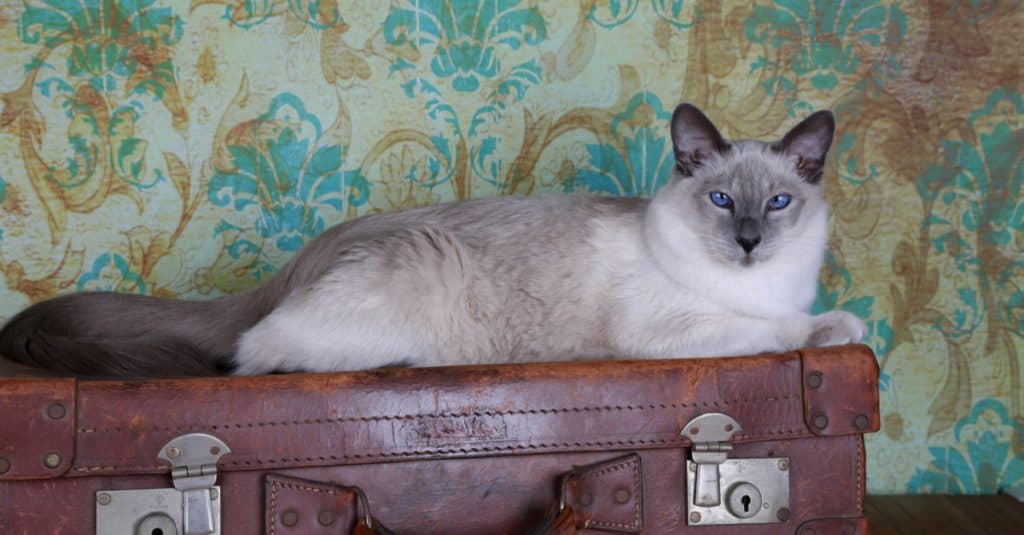Nebelung
Felis Catus
Advertisement
Nebelung Scientific Classification
- Kingdom
- Animalia
- Phylum
- Chordata
- Class
- Mammalia
- Order
- Carnivora
- Family
- Felidae
- Genus
- Felis
- Scientific Name
- Felis Catus
Read our Complete Guide to Classification of Animals.
Nebelung Conservation Status
Nebelung Facts
- Diet
- Omnivore
View all of the Nebelung images!
“In German, the word Nebelung means ‘creature of the mist’.”

Nebelung Traits: What to Know Before You Buy
Although they are recognized by TICA as their own breed, Nebelung cats are essentially longer-haired Russian blues. They have the Russian blue cat’s coat color of blue-gray with silver tips, but with medium-long strands of a double coat.
See all of our expert product reviews.
Being a Nebelung cat owner means having grooming and care responsibilities unique to the species. Both males and females need weekly brushing to ensure they do not develop matting. Although they are not especially needy, Nebelungs do not like lifestyle changes or routine disruptions such as when home-based owners go back to office-based work or school. They can become anxious if not well-socialized as a kitten.
The breed is healthy overall without any major inherited health problems. But they can become finicky about their food and even spoiled eaters. This can lead to obesity and weight-related health problems. Otherwise, when well cared for, they often live as long as 18 years.
Origin
The Nebelung is a rather new breed, originating in America during the 1980s. A cat owner named Cora Cobb of Colorado admired the beautiful medium-long gray coat of one of her male Russian blue-type and female shorthair black cats’ offspring. She kept this kitten from their first litter and named him Seigfried after a character in a Wagner opera. Cora noted Seigfried’s uniquely sweet, gentle, and loyal nature and beautiful body characteristics she had not seen in her other cats. To pass these loving and attractive traits of Seigfried’s on, Cobb later bred the adult male with a similar medium-long coat female from a second litter with the same parents. That female was named Brunhilde, also after a character in the Wagner opera. The result of these two unique parents is the bloodline recognized as Nebelung today.
The cat breed’s name Nebelung is German and means “creatures of the mist.” They have long, muscular, and athletic bodies with slightly pointed heads. Their foreheads are straight and their nose tips are shallow with a concave curve. The cats’ ears are large and pointed with green to yellow-green eyes set widely apart. It is the breed’s coat that first makes them stand out. Their beautifully rich, blue-gray, and shiny medium-long double coats are fully developed by their second year of life. Adult males typically have more neck ruff than females, like their distant feline cousins the lions.
Personality

©mama_mia/Shutterstock.com
Health and Entertainment for your Nebelung
See all of our expert product reviews.
Nebelungs are adored for their affectionate, loving, loyal, and sweet personalities. They are gentle yet playful, making them a perfect companion for family members of all ages. These intelligent cats closely bond with their owners.
Their devotion to their humans often leads these cats to follow family members around the house. They simply enjoy knowing what their people are doing and like to be part of the action, even just by observing. They are lap cats who enjoy being pampered and petted. In a family setting, the Nebelung often chooses one or two favorite humans with whom they bond most closely.
The breed feels most confident and secure within a well-established routine. They do not like change and require some time to adjust to moving from one household to another, the addition of new family members, or other disruptions. During such changes, it is important to show your Nebelung lots of love and affection to reassure them that all is well!
The Nebelung personality relates well with cat buddies they can live and play within the same household. If your Russian blue longhair breed struggles with recent changes, it is often a good idea to find a compatible cat brother or sister they can befriend and enjoy.
You will rarely hear your Nebelung meowing. They are a soft-spoken breed that usually only vocalizes when something is not right in their world such as when the litter box needs cleaning or their food dish is empty.
When visitors come to the home, the longhaired Russian blues typically hide under a bed or keep themselves at a safe distance. Otherwise, they are highly affectionate and love to engage in play with their loved ones.
Size and Weight

A Nebelung typically weighs about 7-15 lbs.
©Therese Elaine/Shutterstock.com
Nebelung cats are medium size in physical build, typically only weighing from seven to 15 pounds at a height of nine to 13 inches. They are longer than shorthair Russian blue cats, one of their original breeds. Their legs, tail, neck, and body all have longer or wider measurements than the famed Russian blues. Males and females do not vary widely in size or weight. But, as with most cats, males can be slightly larger, particularly after neutering. Males also often have lion-like neck ruff that differentiates them from females and gives them a slightly bolder appearance.
Price

It is important to adopt a Nebelung from a reputable shelter, rescue, or breeder.
©mama_mia/Shutterstock.com
Because of their long blue-gray coats, bright green eyes, and sweet, gentle dispositions, Nebelung cats are in high demand. This demand affects their price. But also because they are a relatively new domestic cat breed recognized by multiple breeding associations, they are hard to find. This means they are not typically found in animal shelters or rescue centers for pet adoption and prospective owners must find a reputable breeder.
If you are lucky enough to find one of this breed’s beautiful cats in a shelter, you will typically pay a price of anywhere from $50 to $200 for adoption. But if you purchase one from a reputable breeder, you can expect upfront costs of between $600 and $1200. It is important to be wary of people selling so-called Nebelung cats on the internet unless they have papers indicating the cat’s legitimacy as a member of this breed. Many medium-long-haired pets are listed on various sites under the breed, but long hair alone does not make the cat a Nebelung. There are many other traits specific to the breed and dictating their price, from their loving and gentle personality to their intelligence and key physical characteristics.
One of the most important breed facts is that owning a Nebelung is often more expensive than owning other breeds of cats, particularly shorthair breeds. Not only do they have the typical food, grooming, and vet care costs associated with any cat’s ownership, but they also require some special care and attention. Their long coats require weekly brushing to prevent tangles that lead to matting. They sometimes need to visit a groomer for thinning of the coat, matting removal, or a complete shave to grow a fresh coat.
Members of this breed are often picky eaters. Your new cat may come with an expensive taste, turning its nose up to typical cat food and wanting a more costly brand. The average owner pays between $120 and $150 per month for their food, treats, and health supplements recommended by a veterinarian. These cats are also sensitive about the care and upkeep of their litter boxes, so you must be prepared to shoulder the cost of their preferred brand.
Routine veterinary care and other health costs for a member of this breed range between $50 and $120 per year.
Kittens
Kittens of the breed are among the cutest you can find in the cat world! They are fluffy, sweet, and playful. Their widely set green eyes make them appear as intelligent and curious as they are, eager to take in the world around them.
Kittenhood is an important time in any Nebelung’s life as the fluff balls need early socialization and handling to ensure they are not anxious or timid cats. Of course, the species is known for running to hide in different rooms or under beds when visitors come into their domains. But being around other domestic cats, people and pets is a great idea to help curb their natural shyness. Social exposure can also cause these kitties to give extra lap cuddles to the humans they love.
One of the cutest traits of Nebelung kittens is their quiet little meow. The breed is known for being quieter than many other types of cats. Throughout their lifetimes, these cats tend to “speak” only when they need to make a point such as when their water bowl or food dish is empty. But as kittens, their sweet voices tend to be very soft and quiet. Some will vocalize in soft little squeaks as they learn how to communicate.
Like the adults, the breed’s kittens are medium-sized when compared to other cat breeds. But there is no denying the special cuteness of their irresistibly fluffy blue-gray coat.
Lifespan

Nebelungs are capable of living long, healthy lives with the proper care.
©Waxwing Media/Shutterstock.com
This breed of cats typically lives long, healthy lives because the domestic breed has yet to acquire any inherited health problems. This means that their lifespan is largely determined by how their owners care for them and other factors. While most live between 13 to 16 years, it is not uncommon for members of this breed to live 18 years. Some have even lived to be as old as 20 or older.
Nebelung Breed vs. Mixed

Balinese Cat mixes can oftentimes be mistaken for Nebelungs
©Jenni Ferreira/Shutterstock.com
Although their most identifiable feature is their medium-long blue-gray hair, a Nebelung has many other important traits specific to their species. If they are not from this breed, they may be a mixed breed or a member of another medium-long family like the Oriental Longhair. The Oriental longhair is often mistaken as a Nebelung and vice-versa because both breeds can have similar gray coats.
One of the most important facts to note about their physical appearance and confirm a cat is a Nebelung is the presence of widely-set green eyes. TICA.org set breed standards for the Nebelung and notes that some members of the cat breed have yellow-green eyes during their kitten phase. These deepen in color by the age of two years. At that time, you can note a green halo that forms around the pupil and overall green color.
The breed’s coat is entirely blue-gray and medium-long. If a kitten or cat has patches of other colors or a non-gray coat, it is possibly a mixed cat, an Oriental longhair, Balinese, Javanese, Himalayan, or other breeds. Other coat traits that can make the breed easier to identify are the silver tips on the blue-gray hairs that give the cat’s coat a shimmery, misty look.
View all 65 animals that start with NNebelung FAQs (Frequently Asked Questions)
What is a Nebelung cat?
This cat is a specific breed recognized by TICA.org. It is a relatively new breed with a history only dating to the 1980s, born from a shorthair mother and Russian blue father. These cats are identifiable according to their beautifully silky medium-long blue-gray coats, green wide-set eyes, and pointy ears.
How do I identify a Nebelung cat?
This breed is most easily recognized for its medium-long blue-gray coat, pointed ears, and green, widely set eyes. They are medium-sized cats but have long bodies, long legs, and wide necks. Members of the breed are soft-spoken, typically only vocalizing when they have specific needs.
Are Nebelung cats aggressive?
Members of this breed are among the sweetest and most gentle of cats. This personality and demeanor make them perfect additions to family households. They also get along well with other cats.
How big do Nebelung cats get?
The breed’s adults typically grow to medium size of 7 to 15lbs. Their height as an adult is 9 to 13 inches. They can become obese if they are fed too much, particularly if they are over-indulged as notoriously picky eaters.
Are Nebelungs rare?
Members of this breed are rare because they are a relatively new designer breed. They only came into being in the 1980s. This makes them hard to find for adoption in animal shelters and typically necessitates adoption or purchase through reputable breeders.
Do Nebelungs like other cats?
This breed is very gentle, sweet, and loyal. They are great with other cats, particularly when they are socialized from a young age. They enjoy other cats’ companionship.
What breeds make a Nebelung?
The breed was developed from a shorthair mother and a Russian blue shorthair father. They are often called Russian blue longhair cats because of this Russian blue heritage.
How much is a Nebelung cat worth?
These Russian blue longhairs typically cost from $500 to $1200 when purchased from a reputable breeder. But they are considered priceless by their humans because of their naturally sweet, loyal, and gentle nature!
How long do Nebelung cats live?
The breed is healthy, not yet having any inherited health threats for which it is known. They typically live 13 to 16 years when well cared for. But many have lived to 18 years.
Thank you for reading! Have some feedback for us? Contact the AZ Animals editorial team.
Sources
- Wikipedia, Available here: https://en.wikipedia.org/wiki/Nebelung
- petfinder, Available here: https://www.petfinder.com/cat-breeds/nebelung/
- thesprucePets, Available here: https://www.thesprucepets.com/nebelung-cat-breed-profile-4770585
- DailyPaws, Available here: https://www.dailypaws.com/cats-kittens/cat-breeds/nebelung
- prrs&wags, Available here: https://www.pumpkin.care/cat-breeds/nebelung/
- catbreedslist.com, Available here: https://www.catbreedslist.com/all-cat-breeds/nebelung.html
- ASPCA, Available here: https://www.aspcapetinsurance.com/resources/nebelung-cat-facts/
- All About Cats, Available here: https://allaboutcats.com/cat-breeds/nebelung
- realesa letter, Available here: https://www.realesaletter.com/blog/cat-breeds/nebelung-cat
- TICA, Available here: https://www.tica.org/breeds/browse-all-breeds?view=article&id=859:nebelung-breed&catid=79
- ThePets, Available here: https://thepets.net/nebelung-cat-breed/
- gokitty!, Available here: https://gokitty.com/kitten/listing/breed/nebelung/
- kidadl, Available here: https://kidadl.com/animal-facts/nebelung-facts

















